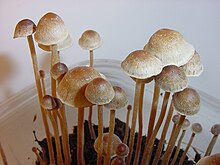
Psilocybe cubensis, commonly known as the magic mushroom, shroom, golden halo, cube, or gold cap, is a species of psilocybin mushroom of moderate potency whose principal active compounds are psilocybin and psilocin. It belongs to the fungus family Hymenogastraceae and was previously known as Stropharia cubensis. It is the best-known psilocybin mushroom due to its wide distribution and ease of cultivation. This mushroom being optimal for home cultivation specifically, as was suggested in the 1970s, is primarily what led to P. cubensis being the psilocybin mushroom species most common on the black market as a street drug.

Psilocybin mushrooms, commonly known as magic mushrooms or shrooms, are a polyphyletic informal group of fungi that contain psilocybin, which turns into psilocin upon ingestion. Biological genera containing psilocybin mushrooms include Psilocybe, Panaeolus, Inocybe, Pluteus, Gymnopilus, and Pholiotina.

Psilocybe is a genus of gilled mushrooms, growing worldwide, in the family Hymenogastraceae. Most or nearly all species contain the psychedelic compounds psilocybin and psilocin.
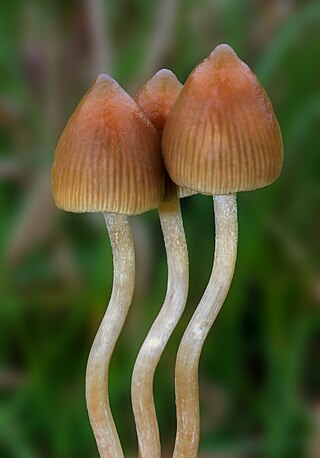
Psilocybe semilanceata, commonly known as the liberty cap, is a species of fungus which produces the psychoactive compounds psilocybin, psilocin and baeocystin. It is both one of the most widely distributed psilocybin mushrooms in nature, and one of the most potent. The mushrooms have a distinctive conical to bell-shaped cap, up to 2.5 cm (1 in) in diameter, with a small nipple-like protrusion on the top. They are yellow to brown, covered with radial grooves when moist, and fade to a lighter color as they mature. Their stipes tend to be slender and long, and the same color or slightly lighter than the cap. The gill attachment to the stipe is adnexed, and they are initially cream-colored before tinting purple to black as the spores mature. The spores are dark purplish-brown in mass, ellipsoid in shape, and measure 10.5–15 by 6.5–8.5 micrometres.

Psilocybe cyanescens, commonly known as the wavy cap or potent psilocybe, is a species of potent psychedelic mushroom. The main compounds responsible for its psychedelic effects are psilocybin and psilocin. It belongs to the family Hymenogastraceae. A formal description of the species was published by Elsie Wakefield in 1946 in the Transactions of the British Mycological Society, based on a specimen she had recently collected at Kew Gardens. She had begun collecting the species as early as 1910. The mushroom is not generally regarded as being physically dangerous to adults. Since all the psychoactive compounds in P. cyanescens are water-soluble, the fruiting bodies can be rendered non-psychoactive through parboiling, allowing their culinary use. However, since most people find them overly bitter and they are too small to have great nutritive value, this is not frequently done.

Psilocybe mexicana is a psychedelic mushroom. Its first known usage was by the natives of North and Central America over 2,000 years ago. Known to the Aztecs as teotlnanácatl, from the Nahuatl teotl ("god") + nanácatl ("fungus"). This species was categorized by French botanist Roger Heim.
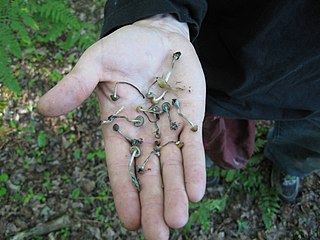
Psilocybe quebecensis is a moderately active hallucinogenic mushroom in the section Aztecorum, having psilocybin and psilocin as main active compounds. Native to Quebec, it is the most northern known psilocybin mushroom after Psilocybe semilanceata in northern Scandinavia. Macroscopically this mushroom somewhat resembles Psilocybe baeocystis.
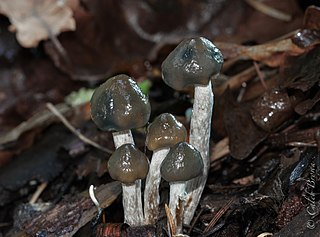
Psilocybe baeocystis is a psilocybin mushroom of the family Hymenogastraceae. It contains the hallucinogenic compounds psilocybin, psilocin and baeocystin. The species is commonly known by various names such as bottle caps, knobby tops, blue bells, olive caps.

Pholiotina cyanopus is a species of fungus that contains psychoactive compounds including psilocybin and the uncommon aeruginascin. Originally described as Galerula cyanopus by American mycologist George Francis Atkinson in 1918. It was transferred to Conocybe by Robert Kühner in 1935 before being transferred to Pholiotina by Rolf Singer in 1950. A 2013 molecular phylogenetics study found it to belong to a group of species currently assigned to Pholiotina that are more closely related to Galerella nigeriensis than to Pholiotina or Conocybe. It is likely that it will be moved to a different genus in the future, but this has not happened yet.
Psilocybe galindoi is a psychedelic mushroom in the section Mexicana, having psilocybin and psilocin as its main active compounds. It is also known as Psilocybe galindii. The species was named in honor of Mr. Carlos Galindo Arias and his family by Dr. Gastón Guzmán.

Psilocybe samuiensis is a psychedelic mushroom, which has psilocybin and psilocin as main active compounds. It was placed in the section Mexicanae of genus Psilocybe by Gastón Guzmán due to its rhomboid-shaped spores. It has been found in Koh Samui, a small tropical island in Thailand, where some psychoactive species are consumed by both natives and tourists. Chao Samui rarely consume psilocybian fungi. Such local use is usually restricted to local females who do so at the request of foreigners.
Psilocybe plutonia is a small psilocybin mushroom of the family Hymenogastraceae, believed to contain psilocybin and psilocin. It was first documented from Cuba. An older synonym is Agaricus plutonia.

Psilocybe aztecorum is a species of psilocybin mushroom in the family Hymenogastraceae. Known from Arizona, Colorado, central Mexico, India and Costa Rica, the fungus grows on decomposing woody debris and is found in mountainous areas at elevations of 2,000 to 4,000 m, typically in meadows or open, grassy conifer forests. The mushrooms have convex to bell-shaped caps 1.5–2 cm (0.6–0.8 in) in diameter, atop slender cylindrical stems that are up to 7.5 cm (3.0 in) long. The color of the caps changes with variations in hydration, ranging from dark chestnut brown to straw yellow or whitish when dry. The base of the stem is densely covered with conspicuous white rhizomorphs, a characteristic uncommon amongst Psilocybe species.
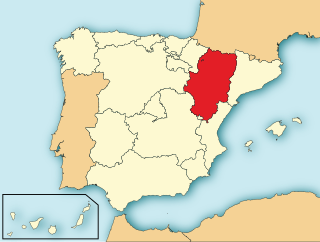
Psilocybe hispanica is a species of fungus in the family Hymenogastraceae. It produces small brown mushrooms with conical to convex caps up to 10 mm (0.4 in) in diameter and stems 16 to 25 mm long by 0.5 to 1 mm thick. Reported as new to science in 2000, it is only known from the Pyrenees mountain range in northern Spain and southwestern France, where it grows on horse dung in grass fields at elevations of 1,700 to 2,300 m. The mushroom contains the psychoactive compound psilocybin. The possible depiction of this species in the 6,000-year-old Selva Pascuala rock art suggests that it might have been used in ancient religious rituals—the oldest evidence of such usage in prehistoric Europe.

Psilocybe hoogshagenii is a species of psilocybin mushroom in the family Hymenogastraceae. The mushroom has a brownish conical or bell-shaped cap up to 3 cm (1.2 in) wide that has an extended papilla up to 4 mm long. The stem is slender and 5 to 9 cm long. The variety P. hoogshagenii var. convexa lacks the long papilla.
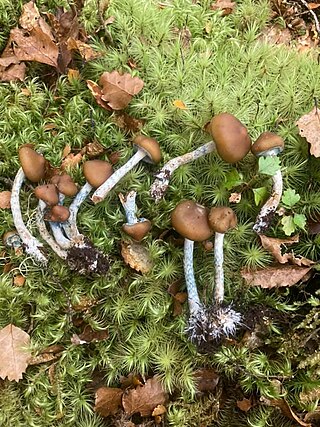
Psilocybe makarorae is a species of psilocybin mushroom in the family Hymenogastraceae. Officially described as new to science in 1995, it is known only from New Zealand, where it grows on rotting wood and twigs of southern beeches. The fruit body (mushroom) has a brownish cap with lighter coloured margins, measuring up to 3.5 cm (1.4 in) wide. The cap shape is either conical, bell-shaped, or flat depending on the age of the mushroom, and it features a prominent umbo. Although the whitish stem does not form a true ring, it retains remnants of the partial veil that covers and protects the gills of young fruit bodies. P. makarorae mushrooms can be distinguished from the similar North American species Psilocybe caerulipes by microscopic characteristics such as the presence of cystidia on the gill faces (pleurocystidia), and cheilocystidia with more elongated necks. Based on the bluing reaction to injury, P. makarorae is presumed to contain the psychedelic compounds psilocybin and psilocin.
Psilocybe subcaerulipes is a species of fungus in the family Hymenogastraceae. It is in the section Zapotecorum of the genus Psilocybe, other members of this section include Psilocybe muliercula, Psilocybe angustipleurocystidiata, Psilocybe aucklandii, Psilocybe collybioides, Psilocybe kumaenorum, Psilocybe zapotecorum, Psilocybe pintonii, Psilocybe graveolens, Psilocybe moseri, Psilocybe zapotecoantillarum, Psilocybe zapotecocaribaea, and Psilocybe antioquiensis. It is endemic to Japan. Fruit bodies grow on the ground in woody debris, and typically stand 6 to 8 cm tall with caps that are 2.5 to 5 cm in diameter. They are chestnut brown, and stain blue if bruised or handled. The species is a psychoactive mushroom, and contains the hallucinogenic compounds psilocybin and psilocin. There have been reports of poisoning caused by the accidental consumption of this mushroom. It has been used in research, specifically, to test the effects of its consumption of marble-burying in mice, an animal model of obsessive-compulsive disorder.

Psilocybe yungensis is a species of psychedelic mushroom in the family Hymenogastraceae. In North America, it is found in northeast, central and southeastern Mexico. In South America, it has been recorded from Bolivia, Colombia, and Ecuador. It is also known from the Caribbean island Martinique, and China. The mushroom grows in clusters or groups on rotting wood. The fruit bodies have conical to bell-shaped reddish- to orangish-brown caps that are up to 2.5 cm (1.0 in) in diameter, set atop slender stems 3 to 5 cm long. The mushrooms stain blue when bruised, indicative of the presence of the compound psilocybin. Psilocybe yungensis is used by Mazatec Indians in the Mexican State of Oaxaca for entheogenic purposes.
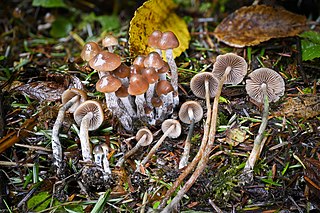
Psilocybe pelliculosa is a species of fungus in the family Hymenogastraceae. The fruit bodies, or mushrooms, have a conical brownish cap up to 2 cm in diameter atop a slender stem up to 8 cm long. It has a white partial veil that does not leave a ring on the stem. American mycologist Alexander H. Smith first described the species in 1937 as a member of the genus known today as Psathyrella; it was transferred to Psilocybe by Rolf Singer in 1958.
Psilocybe washingtonensis is a species of psilocybin mushroom in the family Hymenogastraceae. It is similar in appearance to Psilocybe pelliculosa and P. silvatica, and a microscope is needed to reliably distinguish between them.
